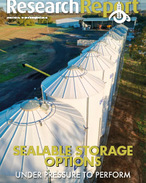This article is 3 years old. Images might not display.
The project, ‘Frost and Heat Management Analytics', a co-investment supported by the Grains Research and Development Corporation (GRDC) and CSIRO, will use both existing data and new research over four years to gain a more precise understanding of how heat and frost events impact crops and how to mitigate risk prior to and during a growing season.
GRDC senior manager Enabling Technologies, Tom Giles, said yield loss from frost and heat events in wheat alone is estimated to cost Australian grain growers more than $500m annually, which is why GRDC has invested $6.2 million into this research to help growers better respond to damaging weather events.
"Responding to heat and frost stress will require both genetic solutions and change to farm management practices. This research will aid growers implement change and make informed management decisions to maintain productivity despite frost and heat risk," he said.
"We developed this investment in a way that ensured it involved the commercial sector from the beginning so the end result would deliver tangible, usable products for growers to improve their production," Giles said.
CSIRO crop scientist, Julianne Lilley, said the investment is exciting for the grains industry because it will address a current gap in understanding the full implications and potential yield loss of frost and heat events.
"What we're aiming to do is collate data to improve crop modelling and better understand the yield damage of frost and heat risk and improve the ability to predict these events," Lilley said.
"The project will bring together the science of temperature mapping and the damage of crops that occur during frost and heat stress and we'll be able to integrate the data across broad, spatial scales," Lilley said.
CSIRO research scientist, David Deery, said data collected and analysed from the project will allow growers to make more informed planting decisions prior to the season, including when to sow, what to sow and where to sow to help mitigate climate risk.
"It will help with big decisions during the season too. If they are impacted by a mid-season frost event or heat stress, they will be able to use the data to make an economically informed decision on whether they turn to hay production, graze the crop or follow it through to harvest," he said.
"We think the data could also be used to develop new site-specific frost and heat insurance options and would aid in insurance assessments," Deery said.
A key element of the project is to ensure the end data and research can be used to develop tangible, commercial products that growers can use on farm to help them mitigate risk and make more informed decisions to avoid yield loss from frost and heat stress.
"In a way, we are thinking about how the end products could be most effective first, then we will go back and develop the science to support them," Deery said.
Giles said: "What's especially exciting about this project is seeing different pieces of a puzzle come together - for example, the project will use the gene-driven models developed through another investment, the National Phenology Initiative (NPI), to generate the variety-specific flowering time data needed to improve the APSIM modelling.
"This linkage between the NPI and this new frost and heat project is a great testament to the value of playing the long game with digital ag," Giles said.























